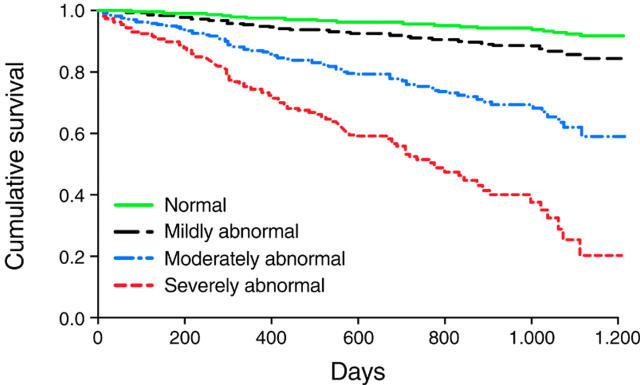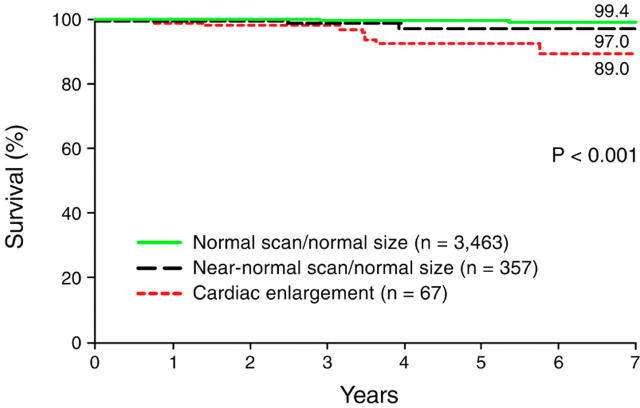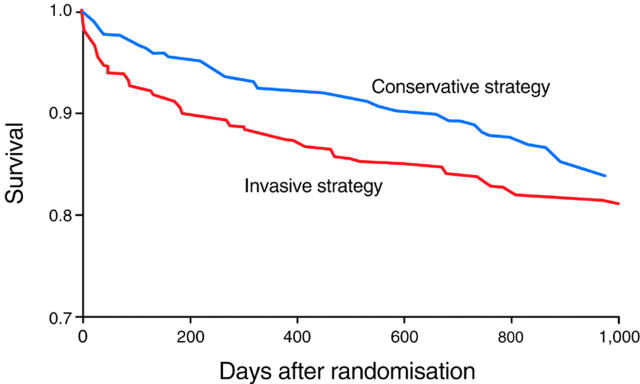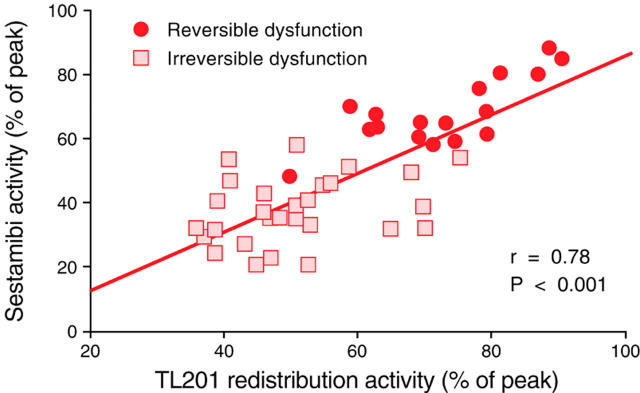Full Text
The Full Text of this article is available as a PDF (126.1 KB).
Figure 1: .
Cumulative survival in 5183 consecutive patients who underwent dual isotope (rest thallium-stress sestamibi) SPECT perfusion imaging as a function of the scan results. The rate of death increased significantly with worsening scan abnormalities. (Reproduced from Hachamovitch et al. Incremental prognostic value of myocardial perfusion single photon emission computed tomography for the prediction of cardiac death. Circulation 1998;97:535, with permission of the American Heart Association.)
Figure 2: .
Cardiac survival in patients with intermediate risk exercise ECGs, subgrouped on the basis of their findings on perfusion imaging. The three subgroups shown—patients with normal perfusion scans and normal heart size; patients with near normal scans and normal heart size; and patients with cardiac enlargement—were significantly different from one another (p < 0.001). Both of the subgroups with normal heart size had a low risk of subsequent cardiac death, with an annual cardiac mortality of less than 0.5%. (Reproduced from Gibbons et al 12 with permission of the American Heart Association.)
Figure 3: .
Survival of patients in the VANQWISH trial, as a function of randomisation to the invasive strategy (early coronary angiography) or the conservative strategy (selective coronary angiography using perfusion imaging). There was no significant difference in outcome comparing the two strategies. (Reproduced from Boden et al16 with the permission of the Massachusetts Medical Society.)
Figure 4: .
Comparison of segmental activity on a resting technetium-99m sestamibi scan with segmental activity on the redistribution image from a resting thallium-201 scan in segments with abnormal contractile function. There was a significant correlation (r = 0.78) between segmental activity on the two scans, although there was some variability. More importantly, activity in those segments with dysfunction which improved after revascularisation generally exceeded 60% of peak counts on both scans. In contrast, dysfunctional segments that did not improve following revascularisation, presumably because they were fibrotic, generally had activity at less than 60% of peak counts on both scans. (Reproduced from Udelson et al. Predicting recovery of severe regional ventricular dysfunction. Comparison of resting scintigraphy with thallium-201 and technetium-99m sestamibi. Circulation 1994;89:2552, with permission of the American Heart Association.)
Selected References
These references are in PubMed. This may not be the complete list of references from this article.
- Boden W. E., O'Rourke R. A., Crawford M. H., Blaustein A. S., Deedwania P. C., Zoble R. G., Wexler L. F., Kleiger R. E., Pepine C. J., Ferry D. R. Outcomes in patients with acute non-Q-wave myocardial infarction randomly assigned to an invasive as compared with a conservative management strategy. Veterans Affairs Non-Q-Wave Infarction Strategies in Hospital (VANQWISH) Trial Investigators. N Engl J Med. 1998 Jun 18;338(25):1785–1792. doi: 10.1056/NEJM199806183382501. [DOI] [PubMed] [Google Scholar]
- Bonow R. O., Dilsizian V., Cuocolo A., Bacharach S. L. Identification of viable myocardium in patients with chronic coronary artery disease and left ventricular dysfunction. Comparison of thallium scintigraphy with reinjection and PET imaging with 18F-fluorodeoxyglucose. Circulation. 1991 Jan;83(1):26–37. doi: 10.1161/01.cir.83.1.26. [DOI] [PubMed] [Google Scholar]
- Brown K. A. Prognostic value of thallium-201 myocardial perfusion imaging. A diagnostic tool comes of age. Circulation. 1991 Feb;83(2):363–381. doi: 10.1161/01.cir.83.2.363. [DOI] [PubMed] [Google Scholar]
- Chua T., Kiat H., Germano G., Maurer G., van Train K., Friedman J., Berman D. Gated technetium-99m sestamibi for simultaneous assessment of stress myocardial perfusion, postexercise regional ventricular function and myocardial viability. Correlation with echocardiography and rest thallium-201 scintigraphy. J Am Coll Cardiol. 1994 Apr;23(5):1107–1114. doi: 10.1016/0735-1097(94)90598-3. [DOI] [PubMed] [Google Scholar]
- DePuey E. G., Rozanski A. Using gated technetium-99m-sestamibi SPECT to characterize fixed myocardial defects as infarct or artifact. J Nucl Med. 1995 Jun;36(6):952–955. [PubMed] [Google Scholar]
- Farkouh M. E., Smars P. A., Reeder G. S., Zinsmeister A. R., Evans R. W., Meloy T. D., Kopecky S. L., Allen M., Allison T. G., Gibbons R. J. A clinical trial of a chest-pain observation unit for patients with unstable angina. Chest Pain Evaluation in the Emergency Room (CHEER) Investigators. N Engl J Med. 1998 Dec 24;339(26):1882–1888. doi: 10.1056/NEJM199812243392603. [DOI] [PubMed] [Google Scholar]
- Gibbons R. J., Chatterjee K., Daley J., Douglas J. S., Fihn S. D., Gardin J. M., Grunwald M. A., Levy D., Lytle B. W., O'Rourke R. A. ACC/AHA/ACP-ASIM guidelines for the management of patients with chronic stable angina: a report of the American College of Cardiology/American Heart Association Task Force on Practice Guidelines (Committee on Management of Patients With Chronic Stable Angina). J Am Coll Cardiol. 1999 Jun;33(7):2092–2197. doi: 10.1016/s0735-1097(99)00150-3. [DOI] [PubMed] [Google Scholar]
- Gibbons R. J., Hodge D. O., Berman D. S., Akinboboye O. O., Heo J., Hachamovitch R., Bailey K. R., Iskandrian A. E. Long-term outcome of patients with intermediate-risk exercise electrocardiograms who do not have myocardial perfusion defects on radionuclide imaging. Circulation. 1999 Nov 23;100(21):2140–2145. doi: 10.1161/01.cir.100.21.2140. [DOI] [PubMed] [Google Scholar]
- Hachamovitch R., Berman D. S., Kiat H., Cohen I., Cabico J. A., Friedman J., Diamond G. A. Exercise myocardial perfusion SPECT in patients without known coronary artery disease: incremental prognostic value and use in risk stratification. Circulation. 1996 Mar 1;93(5):905–914. doi: 10.1161/01.cir.93.5.905. [DOI] [PubMed] [Google Scholar]
- Krawczynska E. G., Weintraub W. S., Garcia E. V., Folks R. D., Jones M. E., Alazraki N. P. Left ventricular dilatation and multivessel coronary artery disease on thallium-201 SPECT are important prognostic indicators in patients with large defects in the left anterior descending distribution. Am J Cardiol. 1994 Dec 15;74(12):1233–1239. doi: 10.1016/0002-9149(94)90554-1. [DOI] [PubMed] [Google Scholar]
- O'Keefe J. H., Jr, Bateman T. M., Barnhart C. S. Adenosine thallium-201 is superior to exercise thallium-201 for detecting coronary artery disease in patients with left bundle branch block. J Am Coll Cardiol. 1993 May;21(6):1332–1338. doi: 10.1016/0735-1097(93)90305-k. [DOI] [PubMed] [Google Scholar]
- Pollock S. G., Abbott R. D., Boucher C. A., Beller G. A., Kaul S. Independent and incremental prognostic value of tests performed in hierarchical order to evaluate patients with suspected coronary artery disease. Validation of models based on these tests. Circulation. 1992 Jan;85(1):237–248. doi: 10.1161/01.cir.85.1.237. [DOI] [PubMed] [Google Scholar]
- Roger V. L., Pellikka P. A., Bell M. R., Chow C. W., Bailey K. R., Seward J. B. Sex and test verification bias. Impact on the diagnostic value of exercise echocardiography. Circulation. 1997 Jan 21;95(2):405–410. doi: 10.1161/01.cir.95.2.405. [DOI] [PubMed] [Google Scholar]
- Tatum J. L., Jesse R. L., Kontos M. C., Nicholson C. S., Schmidt K. L., Roberts C. S., Ornato J. P. Comprehensive strategy for the evaluation and triage of the chest pain patient. Ann Emerg Med. 1997 Jan;29(1):116–125. doi: 10.1016/s0196-0644(97)70317-2. [DOI] [PubMed] [Google Scholar]
- Yusuf S., Flather M., Pogue J., Hunt D., Varigos J., Piegas L., Avezum A., Anderson J., Keltai M., Budaj A. Variations between countries in invasive cardiac procedures and outcomes in patients with suspected unstable angina or myocardial infarction without initial ST elevation. OASIS (Organisation to Assess Strategies for Ischaemic Syndromes) Registry Investigators. Lancet. 1998 Aug 15;352(9127):507–514. doi: 10.1016/s0140-6736(97)11162-x. [DOI] [PubMed] [Google Scholar]
- Yusuf S., Zucker D., Peduzzi P., Fisher L. D., Takaro T., Kennedy J. W., Davis K., Killip T., Passamani E., Norris R. Effect of coronary artery bypass graft surgery on survival: overview of 10-year results from randomised trials by the Coronary Artery Bypass Graft Surgery Trialists Collaboration. Lancet. 1994 Aug 27;344(8922):563–570. doi: 10.1016/s0140-6736(94)91963-1. [DOI] [PubMed] [Google Scholar]
- de Bono D. Investigation and management of stable angina: revised guidelines 1998. Joint Working Party of the British Cardiac Society and Royal College of Physicians of London. Heart. 1999 May;81(5):546–555. [PMC free article] [PubMed] [Google Scholar]
Associated Data
This section collects any data citations, data availability statements, or supplementary materials included in this article.






